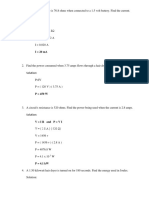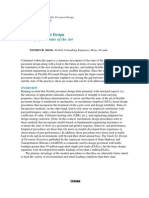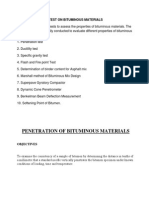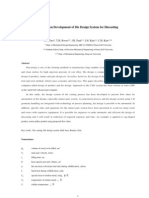A Laboratory Investigation Into Effect of Water Content On The CBR of A Subgrade Soil
A Laboratory Investigation Into Effect of Water Content On The CBR of A Subgrade Soil
Uploaded by
Alberto AmparánCopyright:
Available Formats
A Laboratory Investigation Into Effect of Water Content On The CBR of A Subgrade Soil
A Laboratory Investigation Into Effect of Water Content On The CBR of A Subgrade Soil
Uploaded by
Alberto AmparánOriginal Description:
Original Title
Copyright
Available Formats
Share this document
Did you find this document useful?
Is this content inappropriate?
Copyright:
Available Formats
A Laboratory Investigation Into Effect of Water Content On The CBR of A Subgrade Soil
A Laboratory Investigation Into Effect of Water Content On The CBR of A Subgrade Soil
Uploaded by
Alberto AmparánCopyright:
Available Formats
A Laboratory Investigation into the Eect of
Water Content on the CBR of a Subgrade soil
Samuel Innocent Ko Ampadu
Kwame Nkrumah University of Science and Technology, Kumasi, Ghana
skampadu.soe@knust.edu.gh, sikampadu@yahoo.co.uk
Summary. Residual soils, most of which are lateritic serve as subgrade and even
sub-base and base layers for road and highway pavements in the subregion. However,
the material is known to undergo substantial strength reduction when they become
saturated with water. An understanding of the dependence of the CBR strength of
local soils on water content will contribute towards better design and maintenance
practices. Samples of soil from a study site were prepared by laboratory compaction
at the optimum water content using dierent levels of compaction to obtain samples
at dierent densities. The remoulded samples were then subjected to dierent levels
of wetting in a water tank and dierent degrees of drying in the laboratory and the
CBR determined. The variation of the CBR with the water content is presented and
discussed and related to the matric suction.
Key words: CBR, subgrade, matric suction, water content, remoulded sample,
compaction
Introduction
The road pavement structure in many developing countries consists of rela-
tively thin sub-base and base layers made of lateritic gravel with very thin wa-
ter proong surfacing, founded on a residual soil subgrade. The residual soils
which are the decomposition products of the local geology occur at various
degrees of laterization (Charman 1995) and are known to undergo substantial
strength loss on soaking (Ampadu 2006).
The most common parameter used to evaluate pavement layer strength
is the California Bearing Ratio (CBR). Even though the CBR is not a fun-
damental soil property, its signicance lies in the fact that it is the basis of
the CBR Method of Pavement design which is still, by far, the most popular
pavement design method used in developing countries. The details of the CBR
test are covered in ASTM D 1883-91. The CBR value is inuenced by the wa-
ter content and the dry density as well as the texture of the soil. Normally,
the CBR test in the laboratory is conducted on test samples prepared at the
138 Samuel Innocent Ko Ampadu
dry density and water content likely to be achieved in the eld. Whereas the
eld dry density can be fairly well predicted the diculty is to determine
the stable moisture content at which to conduct the test. The local practice
which is also used in many other countries is to use the 4-day soaked CBR. In
other countries like the UK the design CBR is the CBR corresponding to the
equilibrium water content. Recently, there have been attempts to interpret
the results of CBR test in terms of concepts of unsaturated soil mechanics
(Sanchez-Leal 2002).
The inuence of the moulding water content on the CBR of local lateritic
soils has been studied by Hammond (1970) This investigation seeks to con-
tribute further towards a better understanding of the eect of water content
on the CBR of local soils. Samples of a subgrade material were prepared by
compaction using three dierent compactive eorts and then subjected to
dierent conditions of drying and wetting. The CBR corresponding to each
condition was determined. The soil-water characteristics were also estimated.
The results of the CBR variation with the water content for the dierent dry
densities are presented and discussed and modelled in terms of the matric
suction.
Methodology
Bulk samples of decomposed granite were obtained from depths of 0.3 m to
about 0.6 m in a trial pit. The samples were air-dried for two days and the
index properties determined in accordance with BS 1377: Part 2:1990 using the
wet sieving method for the grading analysis. The compaction characteristics
were also obtained by ASTM D 1557-91 commonly referred to as the Modied
AASHTO compaction using 55 blows of the rammer.
Three dierent test series were conducted. For Test Series 1, using the
optimum moisture content (OMC) obtained from the compaction test, eight
samples were prepared in the CBR mould by ASTM D 1557-91 except that
5 blows of the rammer per layer were used. After preparation, the rst sample,
designated OMC, was covered in a black polythene bag to prevent moisture
loss and stored for 24 hours to ensure moisture equilibriation. The next four
samples, designated wetting were soaked in water for 1, 2, 3 and 4 days
respectively while the last batch of three samples, designated drying was
subjected to various degrees of drying by allowing the samples to dry out for
4, 6 and 8 days respectively. After each period of soaking and of drying, the
samples were covered in black polythene bags for 24 hours to prevent further
moisture loss and to equilibrate the moisture distribution within the sample.
After that each sample was subjected to the CBR test in accordance with
ASTM D 1883-91. After each test, the water contents at the top, middle
and bottom of the specimen were determined. For Test Series 2 and Test
Series 3 the same procedure was repeated except that 20 blows and 55 blows
respectively of the rammer per layer were used in preparing the samples.
Eect of Water Content on the CBR 139
Discussion of Results
The index properties of the soil used for the investigation are shown in Table 1.
In this study gravel is dened as particles larger than 2 mm. The soil used in
this study may be described as a sandy clay of medium plasticity.
Table 1. Summary of Index Properties
Gravel (%) Sand (%) Silt (%) Clay (%) LL PI Gs OMC (%) MDD (Mg/m
3
)
9 28 14 49 49 24 2.65 16.8 1.80
The summaries of results are shown in Tables 2 to 4 for Test Series 1 to 3,
respectively. The initial states of the samples for the CBR tests are plotted on
the compaction characteristics in Fig. 1. The dry densities refer to the values
achieved after sample preparation which means that any eects of volumet-
ric changes arising from drying and from wetting have been neglected. The
mean dry densities achieved were 1.355, 1.649 and 1.706 Mg/m
3
with stan-
dard deviations of 0.013, 0.047 and 0.028 Mg/m
3
for Test Series 1, 2 and 3
corresponding to 75%, 92% and 95% level of compaction respectively based
on the maximum dry density (MDD). The scatter in the dry density values
may be due to variations in the moulding water content during compaction. It
may be noted that in Test Series 3 the same 55 blows of the rammer achieved
only a 95% level of compaction. This observation is consistent with the results
of studies (Ampadu 1997) which show that at the optimum moisture content,
this material gives lower MDD values when fresh samples are used for com-
paction than when samples are reused for each test point. The results of the
water content distribution across the sample during testing showed that on
the average the dierence in water content across the sample was less than
6% and for Test Series 2 and 3, drying appeared to produce a more uniformly
distributed water content across the sample than wetting. The water content
values in the Tables are the average values across the samples.
The variation of the CBR with water content for all three test series are
shown in Fig. 2. The similar values of CBR at higher water contents for both
Series 2 and Series 3 may be due to similar dry density values. The results
show that as the soil dries from the OMC condition, initially there is a rapid
increase in CBR but this slows down as the water content reduces further
especially for lower density samples. The rate of reduction in the CBR during
wetting is relatively slower. In fact the rate of change in CBR per percentage
change in water content was 3 to 7 times larger for drying than for wetting
from the OMC. The practical implication of this is that there is tremendous
benet in terms of increase in CBR in ensuring that the subgrade is well
drained to achieve equilibrium water content below the optimum value. The
results also show that on soaking from the OMC condition, the CBR of the
140 Samuel Innocent Ko Ampadu
Table 2. Summary of Test Results for Test Series 1
Test Condition
Average Water
Content (%)
Dry Density
(Mg/m
3
)
Degree of Sat-
uration (%)
CBR
9.56 1.377 27.4 34
Drying 11.73 1.371 33.3 33
13.37 1.362 37.4 25
OMC 16.58 1.348 45.5 8
Wetting
26.54 1.346 72.6 0.8
26.81 1.348 73.6 0.6
27.03 1.354 74.8 0.4
28.88 1.338 78.0 0.3
Table 3. Summary of Test Results for Test Series 2
Test Condition
Average Water
Content (%)
Dry Density
(Mg/m
3
)
Degree of Sat-
uration (%)
CBR
10.51 1.622 43.9 95
Drying 12.66 1.579 49.5 79
13.54 1.643 58.5 52
OMC 16.09 1.595 64.5 28
Wetting
18.30 1.669 82.5 18
19.35 1.684 89.4 16
20.22 1.703 96.4 16
21.26 1.694 99.8 15
Table 4. Summary of Test Results for Test Series 3
Test Condition
Average Water
Content (%)
Dry Density
(Mg/m
3
)
Degree of Sat-
uration (%)
CBR
12.10 1.697 57.1 94
Drying 13.73 1.674 62.4 79
14.89 1.670 67.2 59
OMC 16.45 1.743 83.8 28
Wetting
18.22 1.733 91.2 20
18.30 1.719 89.5 18
18.59 1.726 92.0 17
21.63 1.688 100 15
subgrade drops and the relative reduction in CBR is between 46% and 98%
for dry densities ranging between 1.71 and 1.36 Mg/m
3
.
The logarithm of the CBR is plotted against water content in Fig. 3.
The results quoted in Croney and Croney (1998) for soil B showing a linear
variation of log CBR with water content over the likely eld water content are
superimposed. The limited results from this study do not show such a linear
Eect of Water Content on the CBR 141
Fig. 1. Compaction characteristics and initial states of test samples
Fig. 2. Variation of CBR with water content for constant dry densities
relationship and suggest that hysteresis eect from wetting or drying may be
important in dening the relationship.
The soil-water characteristics of the same material obtained from a parallel
test programme using the lter paper method (ASTM D-5298-03) are shown
in Fig. 4 for dry densities of 1.79 and 1.51 Mg/m
3
. A linear relationship may be
assumed within the range of saturation investigated with an average air entry
142 Samuel Innocent Ko Ampadu
Fig. 3. Variation of log CBR with water content
Fig. 4. Soil-Water characteristics for dierent densities
pressure of about 420 kPa. Based on this and interpolating and extrapolating
for dry densities used in this study, the corresponding matric suction values,
(u
a
u
w
), for all the test points were estimated. These are plotted against
the unsaturated CBR, CBR
u
on a log-log scale in Fig. 5. The results suggest
a linear log-log model which can be expressed as
Eect of Water Content on the CBR 143
Fig. 5. CBR-matric suction relationship
CBR
u
= CBR
s
u
a
u
w
u
e
n
where CBR
s
is the soaked CBR, u
e
is the air-entry value and n is a constant
which depends on the suction and the dry density.
For this study, n was of the order of 1.4 and about 0.5 for the lower and
for the higher dry densities respectively, and constant for suction values up to
about 15,000 kPa.
Conclusion
From the laboratory CBR test results on a subgrade material at dierent water
contents for three dierent dry densities, it may be concluded that the rate of
change in CBR per percentage change in water content during drying from the
OMC was 3 to 7 times larger than during wetting from OMC. Soaking from
the OMC condition, leads to a relative reduction in CBR of between 46% and
98% for dry densities ranging between 1.71 and 1.36 Mg/m
3
. A linear log-log
relationship between CBR and matric suction is suggested for matric suction
values of up to about 15,000 kPa.
References
Ampadu SIK (1997) The compaction characteristics of residual soils, In: Proc 3rd
Int Conf on Structural Eng Analysis and Modeling, Accra, 711 September 1997
144 Samuel Innocent Ko Ampadu
Ampadu SIK (2006) The loss of strength of an unsaturated local soil on soaking,
Geotechnical Symposium, University of Rome, March 16-17, 2006 (in print)
ASTM D 1557-91 Standard Test Method for Laboratory Compaction Characteristics
of Soil Using Modied Eort. Annual Book of ASTM Standards
ASTM D 1883-91 Standard Test Method for CBR of laboratory-compacted soils.
Annual Book of ASTM Standards
ASTM D 5298-03 Standard Test Method for Measurement of Soil Potential (Suction)
Using Filter Paper. Annual Book of ASTM Standards
BS 13771990 British Standard Methods of tests for Soils for civil engineering pur-
poses, British Standards Institution
Charman JH (1995) Laterite in road pavements. CIRIA Special Publication 47.
Transport Research Laboratory, Department of Transport
Croney D, Croney P (1998) Design and Performance of Road Pavements, 3rd Edn.
McGraw Hill, pp 137138
Hammond AA (1970) A study of some laterite gravels from the Kumasi district.
Building and Road Research Institute, Project Report SM.5
Sanchez-Leal FJ (2002) Interpretation of CBR test results under the shear strength
concept of unsaturated soil mechanics. In: Proc 3rd Int Conf on unsaturated
soils (USAT 2002), Recife, pp 663668
You might also like
- Fours Season O RingsDocument20 pagesFours Season O RingsSudura Si Reparatii ACNo ratings yet
- Comparison of Maximum Dry Density, Optimum Moisture Content and Strength of Granular Soils Using Different Methods of CompactionDocument5 pagesComparison of Maximum Dry Density, Optimum Moisture Content and Strength of Granular Soils Using Different Methods of CompactionIAEME PublicationNo ratings yet
- Sample Value Stream Mapping Template PPT Infographics WDDocument7 pagesSample Value Stream Mapping Template PPT Infographics WDIrshad AliNo ratings yet
- Problem SetDocument4 pagesProblem SetPaul KellyNo ratings yet
- JEA Rules and Regulations For Electric ServiceDocument168 pagesJEA Rules and Regulations For Electric ServiceJonathan FerueloNo ratings yet
- t138 PDFDocument4 pagest138 PDFfarhan sdNo ratings yet
- Flexible Pavement Design SummaryDocument7 pagesFlexible Pavement Design SummarysafeccivilNo ratings yet
- Aashto T 99 and 180 2014Document8 pagesAashto T 99 and 180 2014Shabbir AliNo ratings yet
- Marshall To SuperpaveDocument6 pagesMarshall To SuperpaveWaleed RoomyNo ratings yet
- Mix Design by Marshall MethodDocument27 pagesMix Design by Marshall MethodS K SinghNo ratings yet
- Falling Weight Deflectometer Bowl Parameters As Analysis Tool For Pavement Structural EvaluationsDocument18 pagesFalling Weight Deflectometer Bowl Parameters As Analysis Tool For Pavement Structural EvaluationsEdisson Eduardo Valencia Gomez100% (1)
- HMA Mixture Design: SuperpaveDocument30 pagesHMA Mixture Design: Superpavevinay rodeNo ratings yet
- Inverted Pavement System:: AdvantagesDocument2 pagesInverted Pavement System:: AdvantagesMd Joynul AbadinNo ratings yet
- Transpotation - Emulsions For Highway ConstructionDocument20 pagesTranspotation - Emulsions For Highway ConstructionAtish KumarNo ratings yet
- Civ2201 Soil Mechanics 1-3Document57 pagesCiv2201 Soil Mechanics 1-3Timothy Malinzi100% (3)
- Moisture Sensitivity of Bituminous MixesDocument8 pagesMoisture Sensitivity of Bituminous MixesSudhir VarmaNo ratings yet
- Road Note 8 (Sub Soil Drainage)Document25 pagesRoad Note 8 (Sub Soil Drainage)Someshwar Rao ThakkallapallyNo ratings yet
- Archived: Asphalt Mixture Design IllustratedDocument80 pagesArchived: Asphalt Mixture Design IllustratedraoufNo ratings yet
- 4 Inverted Pavement SystemsDocument10 pages4 Inverted Pavement SystemsprmraoNo ratings yet
- Design of Hot Mix Asphalt Using Bailey Method of GradationDocument8 pagesDesign of Hot Mix Asphalt Using Bailey Method of GradationInternational Journal of Research in Engineering and TechnologyNo ratings yet
- Sabita Mabual 27Document68 pagesSabita Mabual 27Carel De JagerNo ratings yet
- Mix DesignDocument18 pagesMix Designawotina67% (3)
- Chapter 6 Stabilized Pavement MaterialsDocument16 pagesChapter 6 Stabilized Pavement Materialsዳጊ ዳጊ ዳጊNo ratings yet
- Stabilization of Soil by Using Plastic Wastes: AbstractDocument6 pagesStabilization of Soil by Using Plastic Wastes: AbstractUmange Ranasinghe100% (1)
- Pindan Sand Properties StudyDocument15 pagesPindan Sand Properties Studyganguly147147No ratings yet
- En 12697-22Document29 pagesEn 12697-22pedroNo ratings yet
- FCE 412 Geotechnical Engineering IIB: Lecture NotesDocument81 pagesFCE 412 Geotechnical Engineering IIB: Lecture NotesLovian MagandaNo ratings yet
- Chapter 15 - Unpaved RoadsDocument22 pagesChapter 15 - Unpaved RoadsDiyoke Henry100% (1)
- Hveem Design Method For HMADocument8 pagesHveem Design Method For HMASaif Ll100% (1)
- Performance Evaluation of Stone Matrix Asphalt Using Indonesian Natural Rock Asphalt As StabilizerDocument6 pagesPerformance Evaluation of Stone Matrix Asphalt Using Indonesian Natural Rock Asphalt As StabilizerAhmad FauziNo ratings yet
- CBR Improvement of Clayey Soil With Geogrid ReinforcementDocument4 pagesCBR Improvement of Clayey Soil With Geogrid Reinforcementbkollarou9632No ratings yet
- NCHRP RPT 365Document180 pagesNCHRP RPT 365farahNo ratings yet
- Flexible Pavement Design - AashtoDocument17 pagesFlexible Pavement Design - AashtoFarhanah Binti Faisal0% (1)
- 11 22 Emperical and Mechanistic Pavement Design 2Document55 pages11 22 Emperical and Mechanistic Pavement Design 2Shams KhattakNo ratings yet
- Elongation and Flakiness TestDocument10 pagesElongation and Flakiness TestHi270693No ratings yet
- Performance Evaluation of FDR PavementsDocument96 pagesPerformance Evaluation of FDR PavementsAshleyNo ratings yet
- 9a SmaDocument32 pages9a SmaMatt Puerto100% (1)
- Advances in Backcalculating The Mechanical Properties of Exible PavementsDocument11 pagesAdvances in Backcalculating The Mechanical Properties of Exible PavementsArthur Nnang100% (1)
- LWD Simulation in MnPAVE FlexibleDocument6 pagesLWD Simulation in MnPAVE FlexibleLuis MogrovejoNo ratings yet
- Compaction TestDocument9 pagesCompaction TestFernando PascualNo ratings yet
- CEE 346L - Geotechnical Engineering I Lab: Title: Particle Size Analysis by Use of A HydrometerDocument9 pagesCEE 346L - Geotechnical Engineering I Lab: Title: Particle Size Analysis by Use of A HydrometerAbhishek RayNo ratings yet
- Topic No.: 675-000-000 Materials Manual Superpave Mix Design Manual March 29, 2005Document56 pagesTopic No.: 675-000-000 Materials Manual Superpave Mix Design Manual March 29, 2005vinay rodeNo ratings yet
- A Research Paper On Porous Asphalt PavementDocument6 pagesA Research Paper On Porous Asphalt PavementEditor IJTSRDNo ratings yet
- Stabilization of Soil Using AdmixtureDocument17 pagesStabilization of Soil Using AdmixtureVarun Singh ChandelNo ratings yet
- Flexible Pavement DistressDocument13 pagesFlexible Pavement DistressrajudeenNo ratings yet
- Sup Mix PTC.11 PDFDocument69 pagesSup Mix PTC.11 PDFMohamed AbbassyNo ratings yet
- Preparation of Asphalt Mixture Specimens Using Marshall ApparatusDocument8 pagesPreparation of Asphalt Mixture Specimens Using Marshall ApparatusAnbuchelvan CNo ratings yet
- Determination of PenetrationDocument57 pagesDetermination of Penetrationtunlaji0% (2)
- Sand Patch TestDocument5 pagesSand Patch TestgreatpicNo ratings yet
- Application of Perpetual Asphalt Pavment Principles-LandeDocument16 pagesApplication of Perpetual Asphalt Pavment Principles-LandeElba BrizuelaNo ratings yet
- A Review On Stabilization of Soil Using Bio-EnzymeDocument4 pagesA Review On Stabilization of Soil Using Bio-EnzymeInternational Journal of Research in Engineering and TechnologyNo ratings yet
- Final Simulation ReportDocument11 pagesFinal Simulation ReportAytida OhorgunNo ratings yet
- Mashal TestDocument13 pagesMashal TestPhemmy JibadeNo ratings yet
- LBT Road Rehab Supervision ManualDocument291 pagesLBT Road Rehab Supervision Manualuntoni100% (1)
- C 0) C' and ' C' and ' C' ' C C' Effective Undrained Cohesion C' Undrained Angle of Friction ' Effective Undrained Angle of Friction 'Document6 pagesC 0) C' and ' C' and ' C' ' C C' Effective Undrained Cohesion C' Undrained Angle of Friction ' Effective Undrained Angle of Friction 'Dr Wong Kim YuenNo ratings yet
- Lecture No.4 - Soil Stabilization and CompactionDocument10 pagesLecture No.4 - Soil Stabilization and CompactionShehrezad Manuel100% (1)
- Properties of Bituminous Mixes Using Indonesian Natural Rock Asphalt - FurqonDocument11 pagesProperties of Bituminous Mixes Using Indonesian Natural Rock Asphalt - FurqonZakiyah Kamto IrfinNo ratings yet
- Black Cotton SoilDocument4 pagesBlack Cotton Soilibson045001256100% (2)
- RP1047Document6 pagesRP1047Gustavo O. BogadoNo ratings yet
- Experimental Study of Suction-Monitored CBR Test On Sand-Kaolin Clay MixtureDocument4 pagesExperimental Study of Suction-Monitored CBR Test On Sand-Kaolin Clay MixtureHussein BeqaiNo ratings yet
- Shrinkage of Clays Unsat 06Document12 pagesShrinkage of Clays Unsat 06jcazNo ratings yet
- V Compaction: Courtesy of U.S. WICK DRAIN, INCDocument74 pagesV Compaction: Courtesy of U.S. WICK DRAIN, INCramlanNo ratings yet
- Standard Proctor TestDocument6 pagesStandard Proctor TestJulius BaniquedNo ratings yet
- Using Ammonia As A RefrigerantDocument3 pagesUsing Ammonia As A RefrigerantAshfaq Ali KhanNo ratings yet
- Draft Wps Astm A 743 GR - Ca6nmDocument2 pagesDraft Wps Astm A 743 GR - Ca6nmIlham Pane100% (1)
- Docu62192 CloudBoost 100 Installation and Setup GuideDocument40 pagesDocu62192 CloudBoost 100 Installation and Setup GuidetylerabeNo ratings yet
- Centralizator Sarcini Si Echipamente Iza AmanDocument7 pagesCentralizator Sarcini Si Echipamente Iza AmangeorgianconstantinNo ratings yet
- User Manual - IREX Digital Reader 1000SDocument59 pagesUser Manual - IREX Digital Reader 1000SpdvpdvNo ratings yet
- 5 Guidelines For Gear Unit Selection: 5.1 Additional DocumentationDocument21 pages5 Guidelines For Gear Unit Selection: 5.1 Additional DocumentationCarlos LourençoNo ratings yet
- Huili Stainless Steel Welding Water Tank CatalogueDocument20 pagesHuili Stainless Steel Welding Water Tank CatalogueAlienated GatanNo ratings yet
- Parts Manual: Home Find... Go To.Document166 pagesParts Manual: Home Find... Go To.michaelquimica8623No ratings yet
- Sr220 Skid Steer Loader - Tier 3 Manual de PartesDocument906 pagesSr220 Skid Steer Loader - Tier 3 Manual de PartessimonNo ratings yet
- Method Statement For Scaffolding WorkDocument4 pagesMethod Statement For Scaffolding WorkChayank TiwariNo ratings yet
- History MatchDocument78 pagesHistory MatchUmar AbdulNo ratings yet
- Database Teradata Support PlanDocument58 pagesDatabase Teradata Support PlanVinu3012No ratings yet
- Recent Advances in Composite Resins ReviewDocument5 pagesRecent Advances in Composite Resins ReviewChitrang KolawaleNo ratings yet
- Aluminum Wires and Rods 1Document2 pagesAluminum Wires and Rods 1OteranmoralesNo ratings yet
- BS en 12504-3-2005Document14 pagesBS en 12504-3-2005Enrique García Macias100% (3)
- Omega - 8500 8501 8900 8901 - E Technical GuideDocument34 pagesOmega - 8500 8501 8900 8901 - E Technical GuideHugo BeraldoNo ratings yet
- MIMO Part 1Document30 pagesMIMO Part 1Abu Huzaifah BidinNo ratings yet
- Part II Dynamic Bioprocess Simulation Examples and The Berkeley Madonna Simulation LanguageDocument33 pagesPart II Dynamic Bioprocess Simulation Examples and The Berkeley Madonna Simulation LanguageHana HamidNo ratings yet
- Rexroth 4WRLE.e-.W 10-35 3X Servo Solenoid Valves Re29089 - 2009-01Document16 pagesRexroth 4WRLE.e-.W 10-35 3X Servo Solenoid Valves Re29089 - 2009-01Denis KonstantinovNo ratings yet
- Chempro & UPVCDocument28 pagesChempro & UPVCcsdcw fqefqfNo ratings yet
- Chap 2 Erickson Fundamentals of Power Electronics PDFDocument45 pagesChap 2 Erickson Fundamentals of Power Electronics PDFhenrypatriciomunoz1No ratings yet
- 8 Bit General Purpose MicroprocessorDocument4 pages8 Bit General Purpose MicroprocessorraushanNo ratings yet
- Consider An AVL Tree Whose Root Has A Height of 5Document13 pagesConsider An AVL Tree Whose Root Has A Height of 5francisNo ratings yet
- Binary Number SystemDocument18 pagesBinary Number SystemParm KarmNo ratings yet
- Die Casting DesignDocument20 pagesDie Casting Designtiep_design100% (1)
- V.C. Sir Bio DataDocument5 pagesV.C. Sir Bio DataDev MathurNo ratings yet

























































































